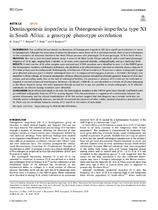| dc.contributor.author | Chetty, M | |
| dc.contributor.author | Roberts, T | |
| dc.contributor.author | Shaik, S | |
| dc.contributor.author | Beighton, P | |
| dc.date.accessioned | 2019-09-16T12:35:36Z | |
| dc.date.available | 2019-09-16T12:35:36Z | |
| dc.date.issued | 2018 | |
| dc.identifier.citation | Chetty, M., Roberts, T., Shaik, S., & Beighton, P. (2019). Dentinogenesis imperfecta in Osteogenesis imperfecta type XI in South Africa: a genotype–phenotype correlation. BDJ Open, 5(1). doi: 10.1038/s41405-019-0014-z | en_US |
| dc.identifier.issn | 2056-807X | |
| dc.identifier.uri | doi: 10.1038/s41405-019-0014-z | |
| dc.identifier.uri | http://hdl.handle.net/10566/4868 | |
| dc.description.abstract | BACKGROUND: The maxillofacial and dental manifestations of Osteogenesis imperfecta (OI) have significant implications in terms
of management. Although the occurrence of abnormal dentine in some forms of OI is well documented, there is scant information
on the association of abnormal dentine in the Black African persons with phenotypic OI III and genotypic OI XI in South Africa.
METHODS: This was a cross-sectional analytic study. A series of 64 Black South African individuals with a confirmed phenotypic
diagnosis of OI III, ages ranging from 3 months to 29 years, were assessed clinically, radiographically, and at a molecular level.
RESULTS: A total number of 64 saliva samples were analyzed and 3 DNA variations were identified in exon 5 of the FKBP10 gene.
The homozygous mutation, c.[831dupC]; [831dupC], was identified in 23 affected persons who had no clinically obvious features of
DI in their primary and secondary teeth. Radiologically, mild features of DI were evident in 10 persons in whom radiographic images
were obtained and were given a Clinical–radiological score of 2. A compound heterozygous mutation, c. [831delC]; [831dupC], was
identified in three siblings. An intraoral examination of these affected persons revealed no clinically apparent features of DI in their
primary and secondary teeth. Due to the lack of radiological facilities, the presence or absence of DI could not be confirmed or
negated. A second compound heterozygous mutation, c.[831dupC]; [1400-4C>G], was identified in a female of 29 years belonging
to the Xhosa linguistic group. Her teeth appeared clinically normal but it was not possible to obtain radiographs. In 37 affected
individuals, no disease-causing mutations were identified.
CONCLUSION: Black African individuals in SA with the homozygous mutation in the FKBP10 gene have clinically unaffected teeth
yet exhibited radiographic features of DI to varying degrees. This characterization is suggestive of a relationship between the
genetic abnormality and the clinical manifestations of DI. The authors suggest that this diagnosis must include teeth that are
clinically and/or radiologically aberrant, and should not exclude the presence of other, milder, dentinal aberrations associated with
OI. There was no correlation between severity of OI and DI in this cohort of individuals. | en_US |
| dc.language.iso | en | en_US |
| dc.publisher | Springer Nature | en_US |
| dc.subject | Osteogenesis imperfecta (OI) | en_US |
| dc.subject | Maxillofacial | en_US |
| dc.subject | Genotype | en_US |
| dc.subject | Phenotype | en_US |
| dc.subject | Black African individuals | en_US |
| dc.title | Dentinogenesis imperfecta in Osteogenesis imperfecta type XI in South Africa: a genotype–phenotype correlation | en_US |
| dc.type | Article | en_US |

